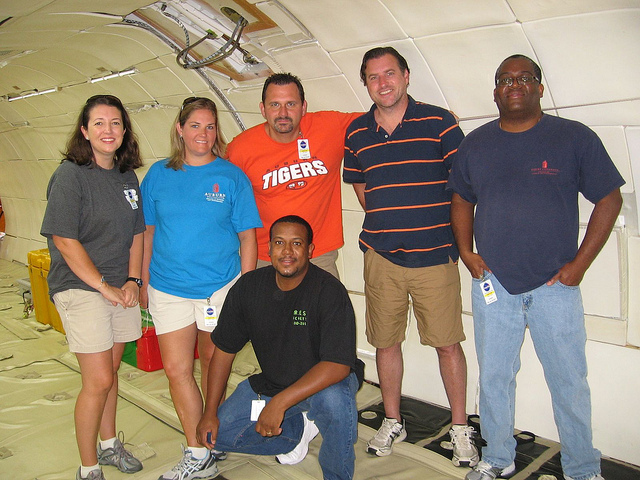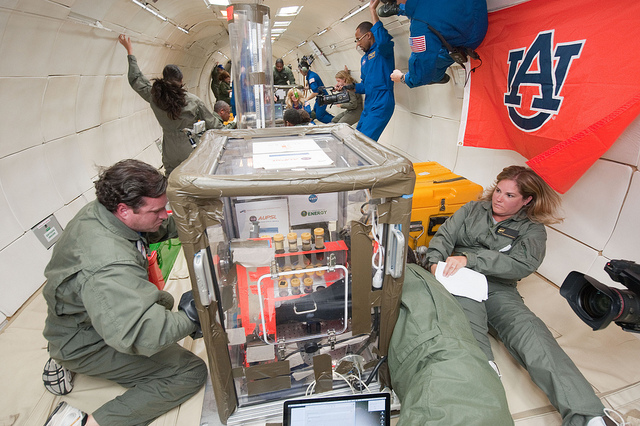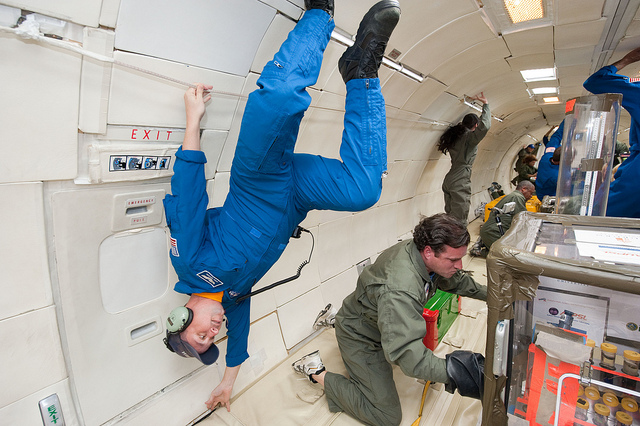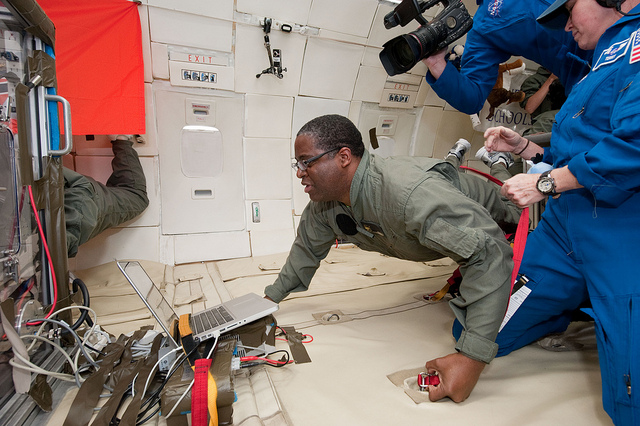COSAM News Articles 2011 September Auburn University and Auburn City Schools educators fly in NASA's 'Weightless Wonder'
Auburn University and Auburn City Schools educators fly in NASA's 'Weightless Wonder'
Educators from Auburn University and Auburn City Schools floated like astronauts during a once-in-a-lifetime flight on NASA's "Weightless Wonder" aircraft. The team of six educators call themselves the "Flying Tigers," and as they floated, they conducted experiments that were set up in a clear plastic box to see how various objects and scientific concepts would alter under a reduced gravity environment. According to the team, words cannot accurately describe the feeling of being weightless.
"The transition to weightlessness is indescribable. … There's no common reference point you can use. It's not a roller coaster, so if you have an impression that it's like this violent shaking and then nothing, it's not like that at all," said Edward Thomas, Auburn University physics professor and Flying Tigers team mentor. "It's almost as if someone is stepping on your chest really, really hard and that's the high gravity phase of the flight. And then, as you make the transition to the zero-G phase, all of this pressure leaves your body and then you float. That's the sensation. We have been trying to figure out the words to describe it. There is nothing in your everyday experience that really can relate to it. You float! It's such a really, really odd and strange and really wonderful and amazingly addictive experience. You just go, 'Wow!'"
The Weightless Wonder is actually a modified Boeing 727 aircraft. The aircraft provides weightlessness 18 to 25 seconds at a time by executing a series of about 30 roller-coaster-like parabolas – a steep climb followed by a free fall – over the Gulf of Mexico. The program is known as the Reduced Gravity Education Flight Program, and it gives educators an opportunity to propose, build and fly reduced gravity experiments during the free falls, thus gathering data in the unique environment as they experience near-weightlessness.
The flight initiated from NASA Johnson Space Center's Ellington Field in Houston, Texas After the Flying Tigers arrived on July 20, they went through extensive physiological training, including safety and motion-sickness training. They also participated in experimental setup and reviews, and curriculum workshops before flying in the Weightless Wonder during the week of July 25. The Flying Tigers' experiments focused on the equilibrium and stability of solids and liquids during the microgravity and hypergravity phases of the flight. The team is currently evaluating findings and drawing conclusions, and will provide the results to NASA as well as students and educators in classrooms around the state.
"I think the strength of our particular group was that we had our teachers propose experiments that they were already doing in their classrooms," Thomas said. "The idea was to carry out a series of experiments on the plane to see what the difference is between what happens on the ground compared to what happens under microgravity conditions. This was a pretty unique experience for me, the teachers in the Auburn School system, and the educator in AMSTI (Alabama Math, Science and Technology Initiative)."
The team put many hours into researching and building the experiments they performed on the Weightless Wonder aircraft. Experiments conducted on the flight included: a density lab using different liquids to see how they would respond in microgravity conditions; a pump system simulated the human circulatory system to discover what would happen to the human body in microgravity conditions; magnets were placed together to repel each other and observations were made on what happened to the magnetic field in microgravity conditions; a parachute drop was simulated to see what would happen when gravitational pull changed drastically, mid-flight; Alka-Seltzer was dropped in water to see what would happen with bubble formation in microgravity conditions; and an accelerometer recorded gravity throughout the entire flight to provide measured results alongside video of each experiment.
"Dr. Thomas has been working on a website, and it has all kinds of education ideas to go along with our experience, along with the videos of the labs we did and ideas on how to integrate the videos into the classroom," said Flying Tigers team participant, Wayne Strickland, science specialist for AMSTI. "The teachers and I that worked together are working to develop ways to integrate (results) into our classroom teaching experience for the students to get an idea of what it's like to be in zero-G. I am also developing some lessons that I can take out to all the schools I work with in the eight-county region to go along with it, along with some video footage and things of that nature."
The Flying Tigers are one of numerous teams nationwide that participated, but the only team from the Southeast. The Flying Tigers team members are: Professor Edward Thomas Jr. from the Auburn University Physics Department, coordinator of the Plasma Sciences Laboratory and Flying Tigers team mentor; Elizabeth Bass and George Clausell from Dean Road Elementary School; Jennifer Spencer from Cary Woods Elementary School; Mark Jones, from Drake Middle School; and Wayne Strickland from AMSTI.
Participation in the flight was part of a partnership between the Auburn Plasma Sciences Laboratory, the Princeton Plasma Physics Laboratory Science Education Program and NASA's Reduced Gravity Office. The Reduced Gravity Education Flight Program is made possible through a new partnership between NASA and the Department of Energy.
"We're hoping to do this again next year. We think that this program, in partnership with Princeton, at least the initial program that we have, is going to run for three years. Over the next two summers, if I can coordinate it all, I hope to have the opportunity to do this again with a couple of other teams," Thomas said. "It really is an experience I think the teachers that participate in it will remember it for a lifetime. It's a very, very unique environment."
Strickland echoed Thomas' remarks: "It was an incredible experience, something I'll never forget. I wish everybody I knew could have a chance to live it."
Latest Headlines
-
04/17/2024
-
04/12/2024
-
04/02/2024
-
04/02/2024
-
04/02/2024




